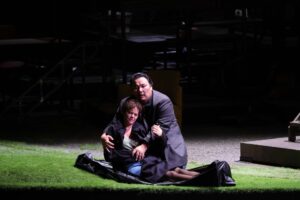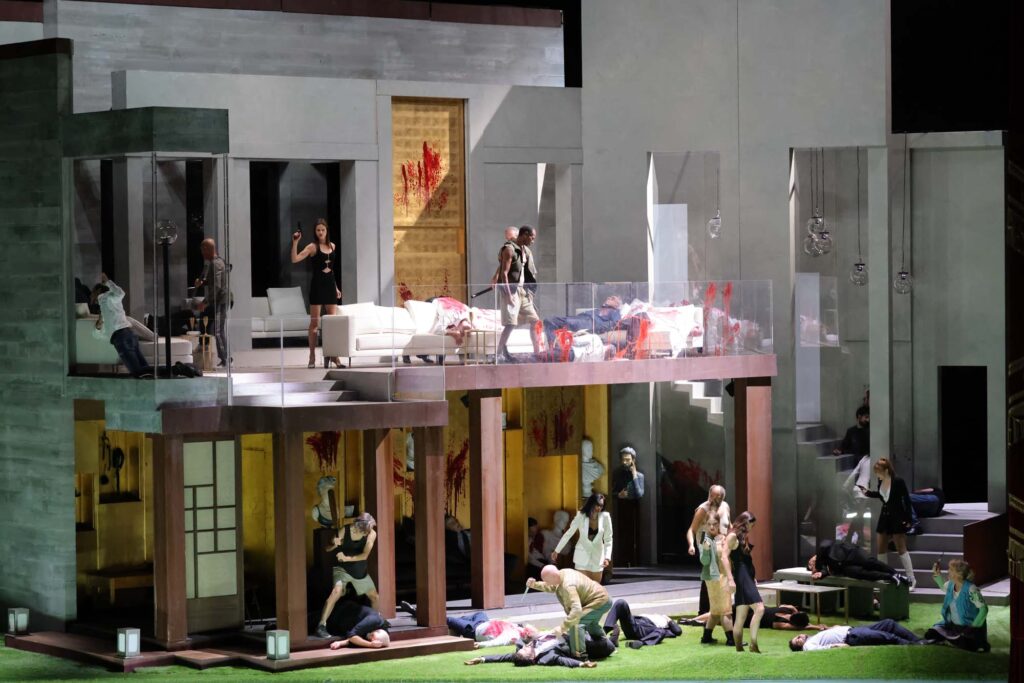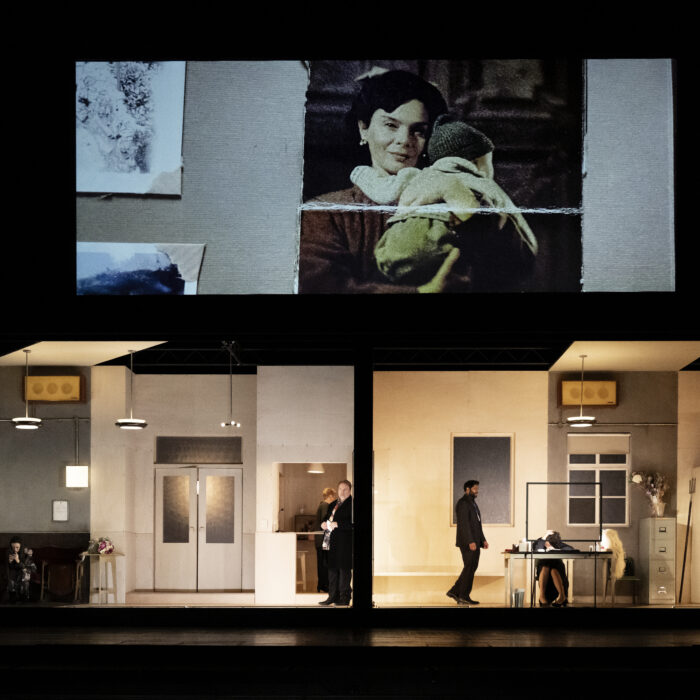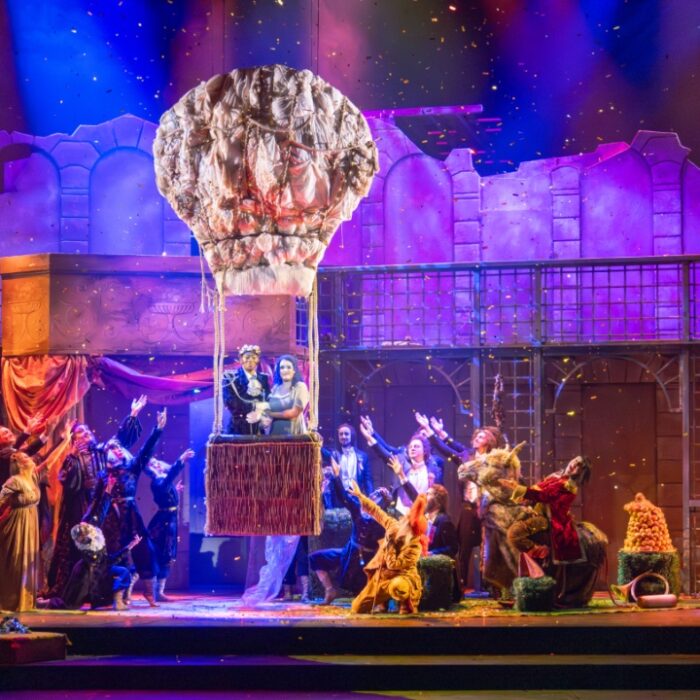
Teatro alla Scala 2024-25 Review: Rigoletto
Mario Martone’s Production Returns with Solid Cast
By Bernardo Gaitan(Credit: Ph. Brescia e Amisano)
After the recurrent “Rigoletto” production by Gilbert Deflo, which has been revived more than ten times since its debut in 1994, the Teatro alla Scala commissioned Mario Martone in 2022 to create a new staging of Verdi’s classic. The result was a contemporary and technologically rich interpretation of the opera, and the theater decided to make a revival for the 2025 season.
Martone’s version is much more violent than traditional stagings. For example, the controversial opening scene, sometimes associated with an orgy, is transformed into a typical millionaire’s party in a minimalist house that could easily appear on the cover of a design magazine. All the guests, elegantly dressed -thanks to the costume design by Ursula Patzak- drink alcohol and consume cocaine recklessly while boasting of their material possessions. The paramedics’ uniforms from the Red Cross and the ragged clothes of the criminals from the neighborhood where Rigoletto and Gilda live add a stark contrast.
The meticulously designed set by Margherita Palli plays a fundamental role in achieving Martone’s vision. The Duca’s elegant house evokes the modern upper-class home, contrasting with Rigoletto’s impoverished neighborhood, where poverty, deprivation, and danger dominate, and finally, Sparafucile’s inn: a peripheral and dangerous space. The rotating stage, real rain during the storm in Act IV (although the lightning effects were poorly coordinated), and the rich, precise lighting design by Pasquale Mari provide the perfect backdrop for the cast to shine.
One of the most debated aspects of both the premiere and this revival was Martone’s alteration of the opera’s ending. After Rigoletto’s iconic line, Ah, la maledizione! he introduces a scene where a gang of criminals breaks into the Duke’s house, killing him and his entire court. Blood flows down the walls, and the bodies lie motionless on the proscenium as the curtain falls on this gruesome image. While the decision to offer a contemporary reading is not inherently problematic, nor are the provocative scenes -such as characters defecating, overdosing, or going through withdrawal- particularly shocking, what is unforgivable and truly transgressive is the break from the tragic essence conceived by Victor Hugo and Verdi. By killing the Duke, the moral core of the work vanishes, because the true horror of Rigoletto lies in the fact that the guilty survive and the innocent die. Gilda’s sacrifice loses its meaning, and Rigoletto ceases to be a victim of cruel fate.
In the program notes, Martone justified his approach by citing the Oscar-winning film Parasite as inspiration, aiming to represent an explosion of accumulated violence and offer a collective ending as a metaphor for rebellion. Monterone and Rigoletto would thus be marginalized fathers, opposing or serving the power, reflecting different forms of resistance or complicity. However, this reading strays far from Verdi’s original pessimism, where tragedy leaves no room for justice or consolation, only irreversible pain. While Martone’s intention to highlight the brutality of social injustice through contemporary stage language was valid, it probably missed the mark in its execution.
Musically, the production had more favorable outcomes. Marco Armiliato, an internationally acclaimed conductor, delivered a robust Verdi reading with great precision in dynamics, subtle orchestral colors, and theatricality in agogic phrasing. Despite some notable instrumental inaccuracies, the Teatro alla Scala Orchestra responded with vigor. Armiliato maintained a reasonable balance between pit and stage, although at moments like the trio of Sparafucile, Maddalena, and Gilda, “Ah, più non ragiono! Amor mi trascina!” or the concertante finale of Act one, he prioritized the prominence of the winds, allowing passages that are often overlooked to come to the fore, even at the expense of partially covering the singers. From the Prelude, where the strings played with expressive tempi, it was clear that this was a personal interpretation, rich in intention and energy.

Ph. Brescia e Amisano
In the title role, Amartuvshin Enkhbat returned to the stage, reprising his performance from the previous season. Vocally, he was superior, with a robust and noble timbre, refined phrasing, excellent technique, and exemplary Italian diction. There were no vocal faults, but his stage presence remained cold and disconnected, reducing the emotional impact of the character. Paradoxically, in two of the role’s most iconic moments -the aria “Cortigiani, vil razza dannata” and the final scene “Dio tremendo! Ella stessa fu colta”- he skillfully sculpted the internal drama of the character: the jester who unravels before the tragedy. However, the lack of expression and stage tension prevented this emotional depth from translating visually, making him a somewhat predictable and dull performer.
Regula Mühlemann portrayed a noble, submissive, and innocent Gilda, with a clear, flexible, and youthful timbre. Her elegant line of singing and refined dynamic control conveyed the character’s tragic depth. The only drawback was a slight weakness in the upper register and a nearly imperceptible projection in the lower. Still, the soprano -known for her Mozart interpretations- shone in the coloratura and agility of “Caro nome che il mio cor,” as well as in the delicate smorzando in the high notes of the duets “Addio speranza ed anima” and “Lassù in cielo vicina alla madre.”
Originally scheduled for all performances, tenor Dmitry Korchak had to be replaced shortly before the premiere by Galeano Salas, who ultimately took over three more performances, leaving the last two to the indisposed tenor. The Mexican-American singer offered a convincing and nuanced Duke of Mantua, supported by a warm and seductive voice. While his projection is not imposing, his timbre resonated well in the hall, compensating with a clean vocal line and a progressive psychological construction of the character: from initial frivolity to final cynicism, passing through a fleeting infatuation in Act two. His interpretation of “La donna è mobile” earned restrained applause, but he particularly shone in “Parmi veder le lagrime,” where he combined elegance, flexibility, and stylistic refinement. Although he could still delve deeper into the character’s dramatic dimensions, his vocal performance, with secure high notes and elegant phrasing, marked a successful debut at the Milanese theater.
Gianluca Buratto’s Sparafucile was excellent, making an immediate impression with his first entrance. The Italian bass, with his dark and powerful timbre, remained firm and penetrating, especially with his enviable low register, notably in the long final F note of the duet Pari siamo. The mezzo-soprano Martina Belli gave an incisive and vocally seductive portrayal of Maddalena, blending sensuality and irony with ease. Meanwhile, Fabrizio Beggi’s Monterone was disturbing and effective, further enhanced by the visual characterization created by Martone, which, along with his strong vocal interpretation, intensified the dramatic effect and earned applause at the end of the performance.
The secondary roles were also well-executed: Carlotta Vichi as Giovanna, Wonjun Jo as Marullo, Pierluigi D’Aloia as Borsa, and Xhieldo Hyseni as Count Ceprano, all contributed solidly to the overall vocal and scenic performance. At the end of the performance, the audience, mostly tourists, gave a warm but restrained applause in a completely packed theater, as was to be expected for one of the most anticipated productions of the season.



